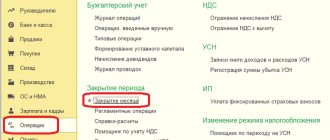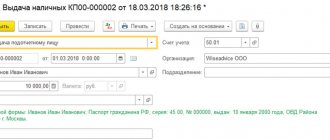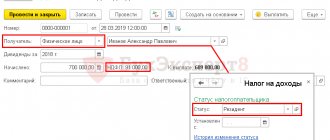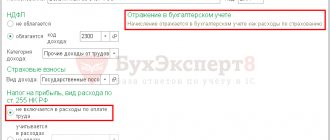The procedure for calculating depreciation of fixed assets in accounting
Depreciation involves the gradual inclusion in expenses of the cost of fixed assets, which is a significant amount for any organization.
Fixed assets can participate in generating income for a long time and have a long service life. Depreciation of fixed assets must be calculated for all groups. But some of the property does not need to be depreciated:
- if the initial cost is within the limits of the maximum value not exceeding 40,000 rubles. (clause 5 of PBU 6/01) (if these objects are accepted for accounting as inventories);
- if the object is on the list of property for which depreciation is not accrued (clause 17 of PBU 6/01).
Read about non-depreciable fixed assets in the material “Rules for calculating depreciation of non-current assets”.
PBU 6/01 is the main document that establishes the rules for calculating depreciation of fixed assets in accounting. When accepting for accounting for each individual object, the organization determines the depreciation procedure based on PBU 6/01 and fixes the parameters: the method of calculating depreciation of fixed assets , and their useful life.
Read about the basic rules for calculating depreciation of fixed assets in the already familiar material “Rules for calculating depreciation of non-current assets.”
OS received free of charge
The organization has the right to depreciate fixed assets received free of charge (clause 17 of PBU 6/01). When such objects are received, their market value is taken into account in account 98 “Deferred income”.
As the value of a gratuitously received fixed asset is transferred to expenses, other income is reflected in accounting in an amount equal to the accrued depreciation (clause 29 of the Methodological Instructions, approved by Order of the Ministry of Finance of Russia dated October 13, 2003 No. 91n). In this case, two transactions are performed simultaneously:
Debit 20 (08, 23, 25, 44, 91...) Credit 02 – depreciation has been accrued on a fixed asset received free of charge;
Debit 98 Credit 91-1 - other income is recognized in the amount of depreciation accrued on a fixed asset received free of charge.
Example of calculating depreciation of fixed assets
Let's look at an example of how to calculate depreciation of fixed assets in practice.
Example
In January 2021, the organization accepted the facility into operation with an initial cost of 72,000 rubles. The fixed useful life is 3 years (36 months).
The linear depreciation method chosen by the organization provides for the following calculation of the annual depreciation amount: 72,000 × 1 / 3 = 24,000. Here 1/3 is the depreciation rate. It is calculated based on the specified number of years of operation. In fact, the annual amount can be obtained by simply dividing the cost by the number of years; in practice, this is how the calculation is made.
The monthly depreciation amount is equal to the result of dividing the annual amount by the number of months in the year: 24,000 / 12 = 2,000. Or, which is equivalent, the result of dividing the original cost by the number of months of use: 72,000 / 36.
Which depreciation method to choose?
Fixed assets wear out and are not renewed at the same time. This is a gradual process. But some objects will depreciate faster, some slower - this depends on the depreciation policy of the enterprise, one of the main tasks of which is to select the optimal methods for calculating depreciation for both accounting and tax accounting purposes. In this case, what should be guided in solving the problem?
For example, in Western countries, when choosing one or another method of calculating depreciation, organizations are guided by the principle of matching income and costs. The point is this.
If, as a result of using an item of fixed assets throughout the SPI, the company receives uniform income, then preference is given to the linear method.
If the income from the operation of property is greater at the beginning of its useful life, and closer to its end, repair costs increase, then it is better to use accelerated depreciation methods (the reducing balance method, the method of writing off the cost by the sum of the numbers of years of the useful life). When calculating depreciation using these methods, most of the cost of fixed assets is transferred to the cost of products (works, services) in the first years of their operation.
When an organization's income depends on the actual output of products, it is more advisable to choose a method of writing off the cost in proportion to the volume of products produced. This method is the most accurate in terms of matching income and expenses. If the volume of output increases, then the organization's expenses for depreciation of property increase. When production volumes fall, depreciation amounts decrease accordingly. When equipment is idle, depreciation does not need to be charged at all. A significant disadvantage of this method is its labor intensity.
Russian practice shows that most domestic organizations in their choice are aimed at bringing accounting and tax accounting closer together, therefore, usually all fixed assets are depreciated using the straight-line method.
Depreciation of fixed assets has been accrued - how to reflect the entries in accounting?
Depreciation amounts are accumulated on the credit of account 02. The account in the debit of the entry depends on the characteristics of the activity in which the object is operated.
| Wiring | Object in use |
| Dt 20, 23, 25 Kt 02 | In the main production, auxiliary, general production workshops |
| Dt 26 Kt 02 | For management purposes |
| Dt 29 Kt 02 | In service farms |
| Dt 44 Kt 02 | In trading and procurement activities For the purpose of selling products in production activities |
| Dt 91 Kt 02 | In other activities |
Depreciation of fixed assets on the balance sheet
The balance sheet form does not provide a separate line for the amount of depreciation accrued as of the reporting date. But this amount participates in the formation of the line indicator 1150 as a regulating value. Namely, to reflect how the indicator in the net valuation is formed for the specified line: the original cost reduced by the amount of accumulated depreciation. The book value of the asset is equal to the difference between the balance of account 01 and the balance of account 02.
In this case, information on depreciation, including accrued, retired, accumulated as of the reporting date, is deciphered by groups of objects and provided to users of the statements in the notes to the balance sheet.
The following disclosure requirements in reporting are established:
- clause 35 of PBU 4/99 (order of the Ministry of Finance of the Russian Federation dated July 6, 1999 No. 43n),
- clause 49 of the regulations on accounting (order of the Ministry of Finance of the Russian Federation dated July 29, 1998 No. 34n),
- clause 32 of PBU 6/01 (order of the Ministry of Finance of the Russian Federation dated March 30, 2001 No. 26n).
The coefficient is not higher than 2
With a coefficient not higher than 2 (clause 1 of Article 259.3 of the Tax Code of the Russian Federation), depreciation can be calculated for the following types of property.
1. Property used for work in conditions of an aggressive environment and (or) increased shifts, except for cases where fixed assets belong to depreciation groups from the first to the third, and depreciation on them is calculated using a non-linear method.
A special coefficient of no higher than 2 is applied to the basic depreciation rate of fixed assets used to work in an aggressive environment and (or) increased shifts, provided that these assets were registered before January 1, 2014.
Extended shift means working in three shifts or around the clock.
An aggressive environment is a set of natural and (or) artificial factors (temperature, toxicity, fire hazard, explosion hazard, etc.) affecting the main product.
To apply the multiplying factor you need to confirm:
— increased wear of the fixed asset under the influence of an aggressive environment;
— the presence of a threat of an emergency as a result of contact of the fixed asset with an aggressive technological environment;
— use of fixed assets in conditions of increased shifts (resolution of the Ninth Arbitration Court of Appeal dated September 2, 2013 No. 09AP-24678/2013).
note
It is dangerous (from the point of view of claims from inspectors) to apply a multiplying factor to equipment that was originally designed to operate in an aggressive environment, that is, it has the appropriate technical characteristics reflected in the technical documentation from the manufacturer. In this case, the aggressive environment cannot be considered as a cause of accelerated wear of equipment or as a source of an emergency (Definition of the Supreme Arbitration Court of the Russian Federation of November 14, 2013 No. VAS-15302/13).
And you can confirm the fact that a fixed asset is located in an aggressive environment with a certificate of its registration and a registration card in the state register of hazardous production facilities, an agreement on insurance of liability for causing harm to third parties during its operation, etc.
1. Own depreciable fixed assets of industrial-type agricultural organizations (poultry farms, livestock farms, fur farms, greenhouse plants) and resident organizations of an industrial-production or tourist-recreational special economic zone (Article 9 of the Law of July 22, 2005 No. 116-FZ) .
2. Fixed assets related to objects with high energy efficiency - according to the list established by Decree of the Government of the Russian Federation of June 22, 2015 No. 600 or to objects with a high energy efficiency class, if defined.
Depreciation of fixed assets in 2018-2019 in tax accounting
The procedure for accounting depreciation in 2018-2019 has not changed. However, in 2021, changes affected tax accounting. Thus, the Law of June 8, 2015 No. 150-FZ (clauses 7–8 of Article 5) introduced amendments to Art. 256, 257 Tax Code of the Russian Federation. They consist in increasing the value of property that is not classified as depreciable.
Previously, this figure was equal to 40,000 rubles. and corresponded to a similar limit in accounting. Now the amount in the Tax Code of the Russian Federation has been increased to 100,000 rubles. The new rules only apply to property put into operation on or after January 1, 2021. For other objects costing over 40,000 and up to 100,000 rubles, which were already in operation before this date, no adjustment is required in the form of writing off the remaining cost.
As we already know, in accounting the amount is 40,000 rubles. represents the upper limit on the cost of non-depreciable assets. In this case, in order to decide on classifying property as fixed assets, an organization can:
- select the maximum limit amount in the accounting policy;
- choose an amount less than this limit;
- take into account objects with a cost less than the limit as part of the inventory;
- do not set a limit by depreciating all objects of any value accounted for as fixed assets.
In tax accounting, the amount of 100,000 rubles is a cost limit that determines the recognition (or non-recognition) of an object as part of depreciable property. Items valued up to this limit are not considered depreciable property. Their full cost at the time the objects are accepted for accounting is written off as material expenses in accordance with subparagraph. 3 p. 1 art. 254 Tax Code of the Russian Federation.
At the same time, the legislator in the same sub-clause. 3 p. 1 art. 254 of the Tax Code of the Russian Federation provides the opportunity to include these amounts in expenses not at once in full, but by distributing the amount over a time interval greater than one reporting period. The period for progressive recognition of expenses is determined as the expected useful life. This is an action similar to accounting depreciation, which allows you to “stretch” the accounting of the cost of non-depreciable property in material expenses.
Used OS
Situation: how to calculate depreciation in accounting for fixed assets that were used by the previous owner?
An organization can charge depreciation on fixed assets that were in use by previous owners, taking into account the period of their operation by the previous owner.
PBU 6/01 does not contain special rules for calculating depreciation for objects that were in operation by previous owners. At the same time, the organization has the right to determine the useful life of this object based on its expected service life. This period can be determined based on an assessment of the technical condition of the object, taking into account its actual wear and tear. Such rules are established by paragraph 20 of PBU 6/01.
For accounting purposes, an organization can determine the useful life of fixed assets according to the Classification approved by Decree of the Government of the Russian Federation of January 1, 2002 No. 1. This document does not give the organization the right to reduce the useful life in comparison with the periods established for a particular depreciation group. In this case, state in the accounting policy that when commissioning fixed assets that were in use by previous owners, their useful life is determined taking into account the period of their operation by the previous owner.
When do differences arise according to PBU 18/02?
A question that worries many accountants. But it is reasonable to approach it taking into account the benefits of taxation on property and profits.
For clarity, we have compiled the following table.
| Cost of objects | Expenses in accounting | Expenses in tax accounting | |
| Including the cost of property at one time in expenses | Gradual inclusion of property value in expenses | ||
| ≤ 40,000 rub. | Objects are not accounted for as inventories, but are depreciated as part of fixed assets | There are differences according to PBU 18/02 | There are no differences according to PBU 18/02 |
| > 40,000 rub. ≤ 100,000 rub. | Depreciation of fixed assets | There are differences according to PBU 18/02 | There are no differences according to PBU 18/02 |
| > 100,000 rub. | Depreciation of fixed assets | Impossible | There are no differences according to PBU 18/02 |
IMPORTANT! The choice in favor of not reflecting differences according to PBU 18/02 does not always entail a reduction in the complexity of accounting. From the point of view of tax reduction, it is often more profitable for an organization to use the right to a one-time attribution of the cost of objects to expenses in both accounting and tax accounting.
What is depreciation?
Depreciation is an accounting method that calculates the wear and tear value of tangible assets, and includes the material value of these assets in parts, divided by the service life of the assets, into the cost of the final product (product, service, etc.).
If we talk about depreciation in simple terms, it is the simplest, but at the same time quite effective technique that allows you to preserve material assets directly within the company. The total amount of monthly deductions to the depreciation fund is determined by the corresponding percentage of the total cost of funds that are classified as fixed assets and are subject to regular wear and tear.
Such property includes:
- real estate objects;
- all kinds of technology;
- production capacity, etc.
These indicators are listed as the total costs associated with ensuring any production process, and are taken into account when calculating the final cost of the goods produced, which includes not only the cost price, but also the markup.
The simplest example that will reveal the essence of depreciation is a car purchased for production purposes. The price of the machine purchased by the company was $30,000. The service life of the car is 5 years. From the date of purchase, every month for the next 5 years, a certain percentage, set based on the price of the car, the level of inflation, as well as other significant factors, will be accrued to the depreciation fund account.
After the allotted five years have expired, the organization will be able to sell the car at the residual price, and purchase a replacement for itself using the money accumulated in the depreciation fund, where at that moment monthly deductions for the last five years and the residual value of the car for which it will be resold.
Results
When deciding how depreciation of fixed assets will be calculated in 2018-2019, the organization has the right to choose: reducing the labor intensity of accounting or the absence of differences according to PBU 18/02.
At the same time, it is reasonable to make a decision also from the point of view of reducing tax expenses. This, in particular, is facilitated by the use of the right to immediately attribute the cost of objects to expenses. You can find more complete information on the topic in ConsultantPlus. Free trial access to the system for 2 days.







